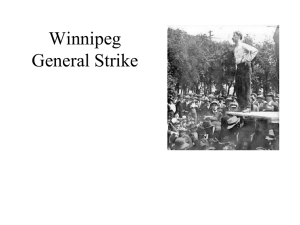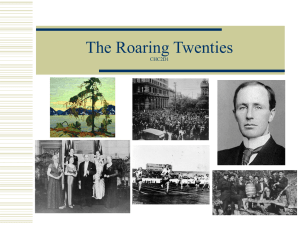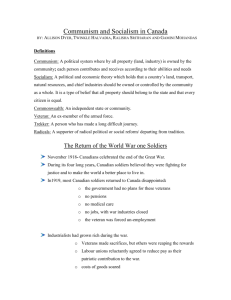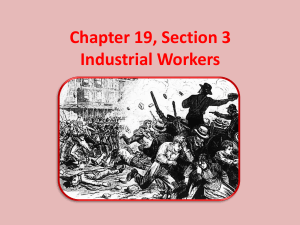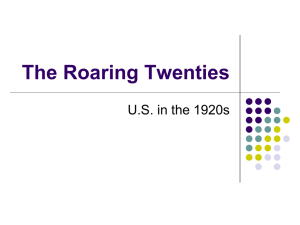powerpoint
advertisement
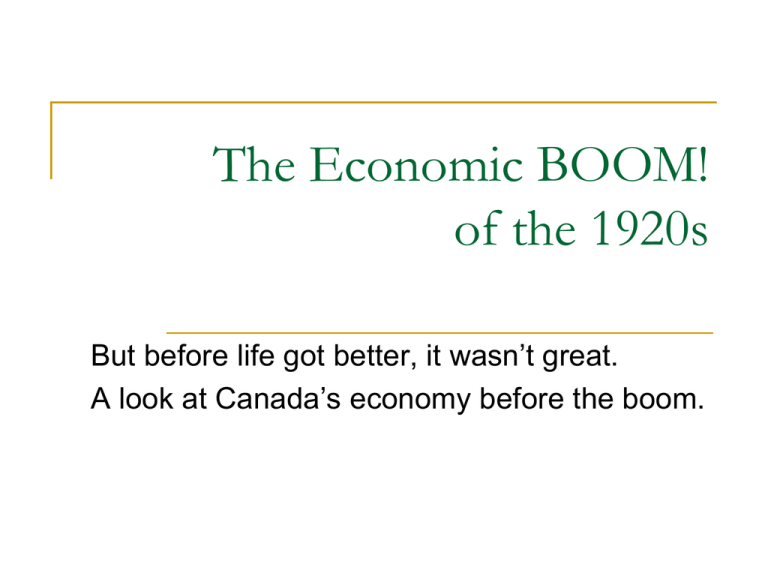
The Economic BOOM! of the 1920s But before life got better, it wasn’t great. A look at Canada’s economy before the boom. Post-War Problems #1: Prohibition Ban on Alcohol. Seen as the root of many other problems #2: Labour Unrest When WW1 ends, many munitions factories closed down Women were under pressure to return to household duties Thousands of returning soldiers were looking for work Labour Unrest Even people who did have jobs were not much better off: why? Rapid Inflation: prices of basic items (food, clothing) had increased greatly, but wages had not increased at all! The cost of living had more than doubled from 1914 to 1919! Soldiers, and other workers, wanted to create unions who would fight with/for them for better job conditions The Country Strikes In 1919, workers across the country staged strikes Miners, steelworkers Cape Breton Machinists Toronto Loggers West Coast Streetcar drivers Windsor None of these strikes were so big as the Winnipeg General Strike of 1919 The Winnipeg General Strike May 1919-June 1919 Building and metal trade workers voted to strike To show their support, 30 000 other workers in Winnipeg walked off the job! “general strike”: almost all industries and key services were shut down Streetcar operators, garbage collectors, postal workers, telephone operators, firefighters, and hydro workers all refused to work The Winnipeg General Strike Ottawa sends Mounties to Winnipeg to put down the strike Bloody Saturday: June 21 Violence erupts! Mounties charge a parade (demonstration) Shots are fired One striker is killed Strike leaders are arrested and sentenced to jail terms The Winnipeg General Strike Together, government, factory owners, and the Mounties had defeated the strikers. Strikers are forced to go back to work Some are forced to promise not to become a union member or be involved in union activities Others were not welcomed back to their job The Results of the Strike Draws attention to the social and economic conditions faced by many working people A royal commission is appointed to investigate the causes of the strike The commission comes up with 3 reasons: High cost of living Poor working conditions Low wages Labour leaders turn to politics they want their voices heard! The BOOM! Gradually, life started to get better for most Canadians, especially by the mid-1920s Business picked up because foreign investors gained confidence in Canada In regions across Canada, industries were growing! Industry #1: Wheat on the Prairies From 1925 to 1928, the prairies enjoyed huge wheat crops War-torn Europe – which had previously made its own – was struggling and wanted Canadian wheat The world price for wheat also moved up steadily Farmers traded their horses for tractors, adding more and more machinery Co-Operatives Co-operatives are businesses owned by farmers. Why is this beneficial? Their goal was to loan money to other farmers at lower interest rates than eastern Canada bankers charged Wanted to sell seed, grains, cattle, and dairy products so that they could skip the middle man and make more profit Industry #2: Pulp and Paper 1920s: production of newsprint became Canada’s largest industry after agriculture Forests of softwood were used to make newsprint Most of the American sources had been used up = giant market for Canadian pulpwood Results: lots of money, but Canada’s forests are being destroyed PROBLEM! Canada’s economy is become more and more dependent on the export of raw materials. Why is this a problem? Industry #3: Hydroelectric Power Quebec and Ontario are big producers Niagara Falls had been used for power since 1895 Rivers were now developed as resources for water power Industries were turning to hydroelectric power instead of coal People wanted electricity for their homes Canada’s output for hydroelectricity became second in the world Industry #4: Oil and Gas Nicknamed the “Oil Age” More Canadians are driving automobiles, so the demand for gasoline and oil soars Oil and gas are always being used for heating and cooking October 1924: oil speculators in Alberta struck it rich Produced a million barrels of oil and large quantities of natural gas Problem! What was used for energy before oil and before hydroelectricity? Coal! Where was that being produced in Canada? The Maritimes! To whom were they now selling their coal? They weren’t… Industry #5: Mining Large deposits of copper were found in the Canadian Shield along the Ontario-Quebec border and in northern Manitoba Sudbury, ON: producing almost 80% of the world’s nickel BC was a top producer for lead and zinc Many of these rich mining deposits were developed with American financing Foreign Investment in Canada At the beginning of the 20th century, Canada’s biggest foreign investor was…? Britain! Bankers from Britain had invested in Canadian government bonds and railroads. They did not invest in industries much because they didn’t think they’d make any money. WW1: British investment slows down Someone else steps in, though… The U.S.! Americans wanted to invest in the rapidly expanding areas of the Canadian economy – the industries Difference in Investors British investors usually left Canadian business people to run the businesses in their own way American investors took greater control over the industries They introduced the Branch Plant System Branch industries are copies of the American parent company Produce the same product as the parent, but they get to have a special stamp: “Made in Canada” Parent company then does not have to pay such high taxes Branch Plant System Good thing: Essential to develop industries Provides jobs Help Canada develop into a powerful nation Bad thing: “Americanization” Important decisions made in the US instead of Canada Top management jobs = Americans Profits sent back to the US Complete economic takeover? Branch Plant System – a Diagram U.S. Parent Company Management Jobs Profits Important Decisions Foreign Investment Money Canadian Branch Company Jobs Taxes CDN Products Research & Development Questions Why did Americans invest in Canada in the 1920s? Correctly use the following terms in a sentence: 1. 2. 1. 2. 3. 3. Branch plant Taxes Parent company Complete a pros and cons chart for American Investment in Canada based on your opinion.



